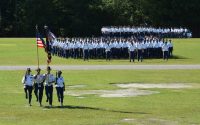
Enlisted U.S. Army Ranks

Before you or your trainee get to basic training, most people don’t have a very thorough understanding of military ranks. Everybody recognizes the ones that commonly show up in movies like sergeant, captain, or admiral, but where they fall on the pecking order of different branches isn’t all that clear.
So whether you don’t know anything about military ranks, or you’re just confused how to put them in order, here’s a breakdown of the Army rank structure.
Army Grade & Rank
Grade and rank correlate with each other, but there is a difference between the two. For example if your trainee is a Private (PVT) their grade will be an E-1. E-1 is short for enlisted pay grade one. Pay grade is important for figuring out the pay scale they are on, as the enlisted pay scale goes from E-1 to E-9. Thus, when your Soldier is promoted or advances to the next rank, they will be in the next higher pay grade. For example, if your PVT gets promoted to PV2, they will now be an E-2.
Soldiers are not referred to as their pay grade, instead they are referred to as their rank. When you are referencing your Soldier, it is correct to refer to them as PVT Jones or PV2 Smith.
Junior Enlisted Army Ranks
In the Army, Junior Enlisted personnel includes privates and specialists, ranging from E-1 to E-3. These ranks receive promotions based on their length of service and time in their current pay grade.
Privates (PVT), or E-1’s, advance to Private 2nd Class (PV2), or E-2, after six months of service. While Private 2nd Class personnel typically attain the rank of Private First Class (PFC), or E-3, after reaching 12 months of service and four months in their grade. Furthermore, soldiers usually achieve the rank of Specialist (E-4) after completing a minimum of two years of service and undergoing specialized training.
Here are some general guidelines for understanding ranks for new enlistees in the Army.
Soldiers who enlist right after high school with no college experience, they will most likely be a PVT.
Soldiers enlisting with some experience in JROTC, they will most likely be a PV2.
If a soldier enlisted with a college degree, they will be a SPC.
Non-Commissioned Officer Army Ranks
Like most other military branches, the Army designates all ranks E-4 and above as Non-Commissioned Officers (NCOs).
E-4
Corporals, E-4’s are often referred to as junior NCOs. However, they are accorded the same level of respect as any other NCO.
Unit commanders have the authority to promote PFCs to the rank of Corporal once specific criteria are met:
- 26 months in service.
- Accumulation of six months’ time in grade, which can be waived to three months under certain circumstances.
- Possession of a security clearance suitable for the Military Occupational Specialty (MOS) in which the promotion is sought. In some cases, advancement may be facilitated by the granting of an interim security clearance.
E-5 and E-6
E-5 is the first level where enlisted soldiers are referred to as Sergeant (SGT). Among the various grades of Non-Commissioned Officers (NCOs), this particular rank arguably holds the most significant influence over lower-ranking soldiers.
The rank of Staff Sergeant (SSG) or E-6, is similar to that of Sergeant in terms of duties and responsibilities. Overall, the fundamental duties and responsibilities of all NCO ranks don’t change, but there are important differences. Most notably, Staff Sergeants typically interact daily with larger groups of soldiers and are generally tasked with the upkeep of more equipment and other property.
Promotion to sergeant (SGT) and staff sergeant (SSG) differs from other ranks in that the promotion is determined through an Army-wide competition. This competition operates on a point system, with points awarded for various factors including firing range scores, performance evaluations, physical fitness, educational attainment, awards, and ranking in promotion boards.
Corporals and specialists must meet the following eligibility criteria:
- Recommendation from a commanding officer
- 36 months of service
- 8 months in current grade
- Successful completion of the Primary Leadership Development Course (PLDC)
- Possession of a high school diploma, GED equivalency, or college degree.
Staff Sergeant candidates must meet the following eligibility criteria:
- Recommendation from a commanding officer
- 84 months of service
- 10 months in current grade
- Successful completion of the primary leadership development course (PLDC)
- Possess a high school diploma, GED equivalency or college degree
Senior Non-Commissioned Officer Army Ranks
E-7
Sergeant First Class (SFC), or E-7 soldiers represent the first tier of senior NCO’s. They aid platoon leaders in soldier training and welfare, functioning as the second-in-command within a platoon and often serving as Platoon Sergeants.
Similar to the promotion process for junior enlisted ranks, commanders have the option to expedite the advancement of soldiers under certain circumstances.
E-8
Master Sergeants (MSG), or E-8’s serve as the primary NCO’s at battalion, brigade, or higher levels, offering expertise and fulfilling various roles concurrently. While MSGs and first sergeants may share the E-8 pay grade, their authority and responsibilities differ.
First Sergeants (1SG) play a vital role in the Army, conducting formations, guiding platoon sergeants, and supporting all enlisted personnel. As senior NCOs, they assist in company-level command.
E-9
Sergeant Majors (SGM), E-9’s, serve as subject matter experts, offering advice on policy development and exerting significant influence, particularly in battalion-level command. SGMs hold the highest enlisted rank pay grade of E-9.
Command Sergeant Majors (CSM) provide professional guidance, oversee policy implementation, and train soldiers within enlisted ranks.
The Bottom Line
The thirteen enlisted ranks within the U.S. Army are organized into three tiers. Junior Enlisted (E-1 through E-4) as they rise through the ranks. Followed by NCOs, who serve as the backbone of leadership (E-4 through E-6). And finally, Senior NCOs (E-7 through E-9), the officers with the most experience.


